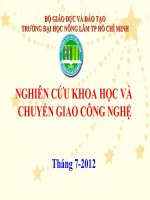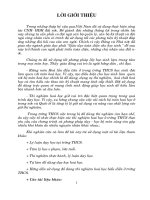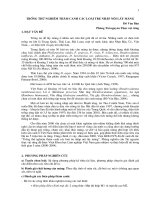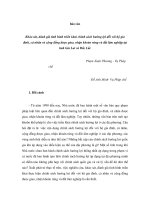canh giac duoc nghiên cứu khoa học
Bạn đang xem bản rút gọn của tài liệu. Xem và tải ngay bản đầy đủ của tài liệu tại đây (2.52 MB, 14 trang )
<span class='text_page_counter'>(1)</span><div class='page_container' data-page=1></div>
<span class='text_page_counter'>(2)</span><div class='page_container' data-page=2>
2
UNIVERSITI KEBANGSAAN MALAYSIA 2017
All rights reserved. No part of this publication may be produced or transmitted
or stored in a retrieval system, in any form or any means without the prior
written permission of the copyright owner.
Published by Universiti Kebangsaan Malaysia (UKM)
Faculty of Pharmacy
Universiti Kebangsaan Malaysia
Jalan Raja Muda Abdul Aziz
50300 Kuala Lumpur
</div>
<span class='text_page_counter'>(3)</span><div class='page_container' data-page=3>
3
THE 2ND INTERNATIONAL CONFERENCE ON PHARMACY EDUCATION AND RESEARCH
NETWORK OF ASEAN (ASEAN PharmNET 2017)
21 & 22 November 2017
GRAND SEASON HOTEL, KUALA LUMPUR
Theme:
Advancing Multidimensional Roles of Pharmacy Education and Research
Organised by:
Faculty of Pharmacy, UniversitiKebangsaan Malaysia, Malaysia
Co-organised by:
Faculty of Pharmacy, UniversitiTeknologi Mara, Malaysia
School of Pharmacy, Taylor’s University, Malaysia
ASEAN PharmNET members
Faculty of Pharmacy, Universiti Kebangsaan Malaysia, Malaysia
Faculty of Pharmacy, Universiti Teknologi Mara, Malaysia
School of Pharmacy, Taylor’s University, Malaysia
Faculty of Pharmacy, University of Medicine & Pharmacy at Ho Chi Minh City, Vietnam
Hanoi University of Pharmacy, Vietnam
Faculty of Pharmacy, Mahidol University, Thailand
Faculty of Pharmacy, GadjahMada University, Indonesia
Faculty of Pharmacy, University of Health Science, Laos PDR
Faculty of Pharmacy, University of the Philippines Manila, the Phillippines
Faculty of Pharmacy, University of Surabaya, Indonesia
International University, Cambodia
School of Pharmacy, Bandung Institute of Technology, Indonesia
University of Pharmacy, Yangon, Myanmar
</div>
<span class='text_page_counter'>(4)</span><div class='page_container' data-page=4>
4
<b>CONTENT </b>
<b>CONFERENCE PROCEEDINGS </b>
Pharmacy Education & Pharmacy Practice (PE)
Pharmaceutical Chemistry & Natural Product (PC)
Pharmaceutics & Drug Delivery System (PD)
Biopharmaceutical Sciences & Pharmaceutical Biotechnology (BB)
Clinical Pharmacy / Social & Administrative Pharmacy (CS)
<b>4 </b>
<b>43 </b>
<b>208 </b>
<b>257 </b>
<b>355 </b>
</div>
<span class='text_page_counter'>(5)</span><div class='page_container' data-page=5>
398
<b>Adverse Events During Treatment of Multidrug-Resistant Tuberculosis: </b>
<b>The First Cohort Event Monitoring in Vietnam </b>
Thuy T. Nguyen2,*, Huyen T. T. Cao1, Hoa D. Vu1, Quang V. Duong1, Hoa M. Nguyen1, Anh
H. Nguyen1, Thuy T. Hoang2,3, Hoa B. Nguyen2,3, Phu X. Vu2,3, Sy N. Dinh2,3, Nhung V.
Nguyen2,3
1
Vietnam National Centre of Drug Information and ADR Monitoring (The National DI &
ADR Center) - Hanoi University of Pharmacy, Hanoi, Vietnam
2
National Lung Hospital, Hanoi, Vietnam
3
National Tuberculosis Program, Hanoi, Vietnam
The corresponding author: Thuy T. Nguyen<b>*</b>, Email address:
<b>Abstract </b>
<i><b>Introduction:</b></i> The safety data during multidrug-resistant tuberculosis (MDR-TB) treatment
have varied for not only Vietnamese patients but also patients in other areas of the world.
<i><b>Objectives:</b></i> This study was conducted to determine the incidence of adverse events (AEs)
that occurred during MDR-TB treatment in Vietnam and to assess risk factors associated
with adverse events. <i><b>Methods: </b></i>AEs were collected from 659 MDR-TB patients enrolled
from April to December 2014 through a cohort event monitoring (CEM) program. Patients
were monitored with a follow-up of approximately 20 months. Adverse events were
determined by clinical criteria and laboratory tests. Cox proportional hazard regression
models were used to explore factors associated with the reported adverse events. <i><b>Results: </b></i>
The cohort enrolled 659 patients in which 81.3% experienced at least one AE during
treatment. Of those with AEs, 18.3% required adjustment of MDR-TB regimen. The most
common AEs including arthralgia, hepatotoxicity and hyperuricemia were observed in
34.7%, 32.2% and 29.3% of patients, respectively. Multivariate regression analysis indicated
that the independent predictors for hepatotoxicity were baseline levels of alanin amino
transferase (HR 1.023; 95%CI 1.008-1.037) and alcoholic status (HR 4.255; 95%CI
1.239-14.616) while pyrazinamide daily dose (HR 1.025; 95%CI 1.002-1.048) and alcoholic status
(HR 2.016; 95%CI 1.084-3.751) were associated with the elevation of serum uric acid.
<i><b>Conclusions:</b></i> Adverse events were common during MDR-TB treatment in Vietnam
including serious ones that required proper interventions. Predictors for hepatotoxicity and
hyperuricemia observed in this study underlined the importance of patient history
investigation, baseline physical and laboratory examination and close monitoring.
</div>
<span class='text_page_counter'>(6)</span><div class='page_container' data-page=6>
399
<b>1. INTRODUCTION </b>
The complicated epidemiological situation of drug-resistant TB in Vietnam as well as in
other countries has been a global concern and become a great challenge for our efforts to
control TB 1. TB treatment requires long term chemotherapy with a combination of many
antibiotics simultaneously, so problems related to drug safety, especially severe adverse
events, can cause a great impact on treatment adherence, thus leading to drug resistance and
difficulty in monitoring TB. As a result, ensuring safe and rational drug use has been
considered as one of the most important objectives of MDR-TB treatment. Activities that
monitor, detect, evaluate and prevent adverse drug reactions related to drugs against TB hold
important roles in the enforcement of treatment efficiency, saving costs, preventing drug
resistance and contributing in patients life quality 2. To date, the rates of yearly spontaneous
reports received by the National DI & ADR Center related to MDR-TB drugs are rather low
and does not reflect the safety of MDR-TB treatment in Vietnam 3. Thus, it is not possible to
detect problems related to drug safety and to provide data for recommendations on regimen
change. Consequently, the implementation of programs enforcing the collection of ADR
reports the evaluation of ADR from MDR-TB drugs is becoming more urgent.
This study may help determine the incidence of adverse events (AEs) that occurred during
MDR-TB treatment in Vietnam. We also aim to assess risk factors associated with the
occurrence of the most reported adverse events.
<b>2. METHODS </b>
<i><b>2.1 Study design </b></i>
We conducted an observational, prospective study based on a Cohort Event Monitoring
(CEM) program.
<i><b>2.2 Setting and study population </b></i>
Nine TB treatment centers in Vietnam were chosen as sentinel sites of the study. The targeted
population of this study was adult (≥ 16 year-old) patients starting MDR-TB treatment at
chosen sentinel sites and enrolled between April 2014 to December 2014. Patients taking part
in other studies (e.g. the STREAM trial) were excluded.
<i><b>2.3 Treatment protocol and follow-up</b></i>
Patients treated in sentinel sites received MDR-TB therapy based on drug susceptibility test
(DST) results and their treatment history. The standardized regimens (IVa and IVb) consisted
of six drugs: kanamycin (or capreomycin), levofloxacin, prothionamide, cycloserine (or
p-aminosalicylic acid PAS), pyrazinamide and ethambutol. The only difference between IVa
and IVb regimens was the injectable drugs. A standardized regimen would be modified based
on DST results and history of allergy.
</div>
<span class='text_page_counter'>(7)</span><div class='page_container' data-page=7>
400
<i><b>2.4 Data collection and analysis </b></i>
Information was filled into paper collection forms, afterwards transfered to Microsoft®
Access 2010 then to SPSS® Statistics 22. For descriptive statistics, nominal and ordinal
variables were presented as percentages, continuous variables with normal distribution were
represented as mean ± SD (standard deviation). Cox multivariate regression analysis was
conducted using stepwise backward method to look for independent factors associated with
AEs due to MDR-TB therapy.
<i><b>2.5 Ethics </b></i>
As this was a study of routinely collected monitoring data and did not affect therapeutic
practice, informed consent from the patients was not obtained.
<b>Table 1. </b><i>Definitions of adverse events of MDR-TB standardized regimens4</i>
<b>Adverse event </b> <b>Definition </b>
<i><b>Hepatoxicity </b></i>
<i>Identified </i>
<i>Suspected</i>
Presence of jaundice, conjunctival discolouration, nausea, vomiting,
loss of appetite, urine abnormal, abdominal pain, pruritus and
elevated AST or ALT level > 3 ULN*, or AST or ALT level > 5 ULN
without symptoms or diagnosed with hepatotoxicity by physician.
Presence of one or some symptoms but no findings to confirm the
diagnosis.
<i><b>Psychiatric </b></i>
<i><b>disorders </b></i>
Presence of one or more of the followings: paranoid reaction,
delusion, abnormal behaviour, bad mood lasts over 2 weeks,
insomnia, distraction, suicide attempt or other psychiatric symptoms,
unless the cause was known such as TB in the central nervous
system, cerebrovascular accident, alcoholism.
<i><b>Arthralgia </b></i> Presence of joint pain, unless the cause was known, e.g.
musculoskeletal tuberculosis, rheumatoid arthritis…
<i><b>Hypersensitivity </b></i>
<i><b>reactions </b></i>
Presence of one of the followings: pruritus, rash, photosensitivity or
other hypersensitivity reactions including anaphylaxis, unless the
cause was known, e.g. food allergy, hepatitis…
<i><b>Renal toxicity </b></i> Presence of oliguria, oedema, at least one elevated serum level of
creatinine, urea after starting MDR-TB treatment, creatinine
clearance < 50 ml/min or diagnosed by physician.
<i><b>Vision </b></i>
<i><b>disorders </b></i>
Vision abnormal or decrease eyesight after starting MDR-TB
treatment or difficult to distinguish colour with no other symptoms or
diagnosed by physician.
<i><b>Hearing </b></i> <i><b>and </b></i>
<i><b>vestibular </b></i>
<i><b>disorders </b></i>
Deaf or hearing loss after starting MDR-TB treatment or diagnosed
by physician or confirmed by audiometry; symptoms consistent with
vestibular disorders such as vertigo and/or loss of balance.
<i><b>Hypothyroidism </b></i>
<i>Identified </i>
<i>Suspected</i>
</div>
<span class='text_page_counter'>(8)</span><div class='page_container' data-page=8>
401
Presence of one or some symptoms but no findings to confirm the
diagnosis
<i><b>Hypokalemia </b></i> At least one serum potassium value ≤ 3,5 mmol/l.
<i><b>Hyperuricemia </b></i> Serum uric acid level > 420 umol/l (70 mg/dl) in men and > 360
umol/l (60 mg/dl) in women or diagnosed by physician.
<i><b>Blood disorders </b></i> Anemia (hemoglobin < 12 g/dL in men and < 13 g/dL in women) or
leucopenia (< 3000 x 109/l) or thrombocytopenia (< 100 x 109/l) or
diagnosed with blood disorders by physician.
<i>*ULN: Upper Limit of Normal </i>
<b>3. RESULTS </b>
<i><b>3.1 Patient characteristics </b></i>
</div>
<span class='text_page_counter'>(9)</span><div class='page_container' data-page=9>
402
<b>Table 2. </b><i>Characteristics of patients treated with MDR-TB therapy (n = 659)</i>
<b>Characteristics </b> <b>n (%) </b>
<i><b>Male sex </b></i> 517 (78.5)
<i><b>Age (year). mean ± SD </b></i>42.4 ± 13.8
<i><b>Weight (kg). mean ± SD </b></i>48.3 ± 9.3 <b> </b>
<i><b>Baseline conditions</b></i>
Diabetes mellitus 104 (15.8)
HIV co-infection 57 (8.7)
Hepatic disease 33 (5.0)
Renal insufficiency 5 (0.8)
Alcoholism 16 (2.4)
History of allergy 13 (2.0)
<i><b>Number of months on treatment. </b></i>
<i><b>median [IQR] </b></i> 19.2 (17.5 - 20.2)
<i><b>Treatment outcome </b></i>
Cure/completion 512 (77.7)
Transfer-out 17 (2.6)
Default 61 (9.3)
Failure 20 (3.0)
Death 49 (7.4)
<i><b>3.2 Adverse events </b></i>
Overall, at least one type of AE was experienced by 536 (81.3%) of 659 MDR-TB patients.
Table 3 demonstrates the frequency and duration of occurence of each type of adverse event
in this cohort. The most common types of AE were arthralgia (34.7%) and hepatotoxicity
(32.2%), respectively. Out of those patients experienced AEs, 18.3% of patients required a
significant change in MDR-TB chemotherapy due to adverse events: dose reduction (5.2%),
</div>
<span class='text_page_counter'>(10)</span><div class='page_container' data-page=10>
403
<b>Table 3. </b><i>Frequency of significant adverse events observed during MDR-TB treatment </i>
<b>Type of AE </b>
<b>Patients experienced </b>
<b>AE </b>
<b>(n = 659) </b>
<b>n (%) </b>
<b>Type of AE </b>
<b>Patients </b>
<b>experienced AE </b>
<b>(n = 659) </b>
<b>n (%) </b>
Arthralgia 229 (34.7) Vision disorders 69 (10.5)
Hepatotoxicity 212 (32.2) Hypokalemia 60 (9.1)
Nausea, vomiting 210 (31.9) Peripheral neuropathy 52 (7.9)
Hyperuricemia 193 (29.3) Abdominal pain 47 (7.1)
Anorexia 188 (28.5) Hyperglycaemia 42 (6.4)
Dizziness 151 (22.9) Hematologic
disorders
23 (3.5)
Headache 127 (19.3) Diarrhea 20 (3.0)
Dermatologic
disorders
119 (18.1) Hypothyroidism 15 (2.3)
Gastritis 116 (17.6) Convulsions 10 (1.5)
Octotoxicity 100 (15.2) Anaphylaxis 4 (0.6)
Psychiatric
disorders
94 (14.3) Vision disorders 69 (10.5)
Nephrotoxicity 85 (12.9) Hypokalemia 60 (9.1)
<i><b>3.3</b><b>Risk factors </b></i>
</div>
<span class='text_page_counter'>(11)</span><div class='page_container' data-page=11>
404
<b>Table 4. </b><i>Multivariable analysis of factors associated with adverse events </i>
<b>Adverse </b>
<b>events </b> <b>Variable </b>
<b>Cases¹ </b>
<b>n (%) </b>
<b>Control</b>
<b>s² </b>
<b>n (%) </b>
<b>p </b>
<b>value </b> <b>HR </b> <b>(95% CI) </b>
<b>Suspected </b>
<b>hepatotoxicit</b>
<b>y </b>
<i>Sex </i>
Male
Female 155
(85.6)
26 (14.4)
362
(75.7)
116
(24.3)
<b>0.019 </b> 1
0.593 (0.384-0.916)
<i>Alcoholism</i>
No
Yes
173
(95.6)
8 (4.4)
470
(98.3)
8 (1.7)
<b>0.011 </b> 1
2.512 (1.231-5.129)
<i>Baseline AST </i>
<i>(U/L) </i>
<b><0.00</b>
<b>1 </b> 1.005 (1.002-1.007)
<b>Identified </b>
<b>hepatotoxicit</b>
<b>y </b>
<i>Age (year) </i> 0.074 1.026 (0.998 -1.056)
<i>Alcoholism </i>
No
Yes
28 (90.3)
3 (9.7)
615
(97.9)
13 (2.1)
<b>0.021 </b> 1
4.255
(1.239-14.616)
<i>Baseline AST </i>
<i>(U/L) </i> 0.083 0.983 (0.963-1.002)
<i>Baseline ALT </i>
<i>(U/L) </i> <b>0.002 </b> 1.023 (1.008-1.037)
<b>Hyperuricemi</b>
<b>a </b>
<i>Alcoholism</i>
No
Yes
180
(93.3)
13 (6.7)
463
(99.4)
3 (0.6)
<b>0.027 </b> 1
2.016 (1.084-3.751)
<i>Diabetes </i>
<i>mellitus </i>
No
Yes
178
(92.2)
15 (7.8)
377
(80.9)
89
(19.1)
0.057 1
0.563 (0.311-1.017)
<i>Pyrazinamid </i>
<i>daily </i> <i>dose </i>
<i>(mg/kg </i> <i>per </i>
<i>day) </i>
<b>0.034 </b> 1.025 (1.002-1.048)
</div>
<span class='text_page_counter'>(12)</span><div class='page_container' data-page=12>
405
<b>5.</b> <b>DISCUSSION </b>
This study was not only the first cohort event monitoring but also the largest study to
date of MDR-TB treatment in Vietnam. It was based on an active surveillance system
with designed forms, had a large sample size, and provided valuable information
about adverse events in Vietnamese population.
Initially, we found that 81.3% of patients developed at least 1 type of AEs after
MDR-TB treatment. The frequency of adverse events in our study was rather higher
than that in previous studies. A study in Russia of 244 MDR-TB patients showed that
73.3% patients had experienced at least one adverse event 5. The rate of patients
experienced AEs in an observational cohort study on drug resistant TB in Pakistan
was 72.3% 6. A cross-sectional study on the treatment of MDR-TB patients in
Vietnam observed 143 (50.7%) patients with at least one adverse event 7. There were
several factors that may have contributed to this result. Firstly, unlike restropective
studies with high probability of missing data, this study method allowed us to collect
and record information more properly. Secondly, patients enrolled in the study were
monitored regularly during treatment by trained healthcare workers following a
complete procedure, thus increasing the ability of detecting adverse events. In
addition, a list of definitions was compiled with detailed descriptions of expected
adverse reactions of MDR-TB medication to optimize AE detection. Therefore, the
results of this study could reflect the incidence of adverse reactions following
standardized MDR-TB therapy in Vietnam.
The severity of AEs varied from mild rash or nausea to the life-threatening
anaphylaxis. The most common adverse events were arthralgia (34.7%),
hepatotoxicity (32.2%), nausea/vomiting (31.9%), hyperuricemia (29.3%) and
anorexia (28.5%). Arthralgia and gastrointestinal disorders were consistent with other
published studies as the most reported. In Nathanson et al., the most observed adverse
events were nausea/vomiting (32.8%), diarrhea (21.1%) and arthralgia (16.4%)8. In
Hoa et al., the most common undesirable reactions of MDR-TB drugs were arthralgia
(35.8%), followed by gastrointestinal disturbance (14.2%) 7. Other clinically
significant adverse events were also observed such as ototoxicity (15.2%), psychiatric
disorders (14.3%), nephrotoxicity (12.9%), vision disorders (10.5%) and hypokalemia
(9.1%).
</div>
<span class='text_page_counter'>(13)</span><div class='page_container' data-page=13>
406
In a systematic review on adverse events of MDR-TB drugs, we found that out of 69
studies, there were 35 studies had observed arthralgia/joint pain but hyperuricemia
was presented in only 2 studies 9. Besides, the rates of hyperuricemia in those studies
were quite low: 2.8% 10 and 12.6% 11. The results of multivariable analysis also
indicated that alcoholism and pyrazinamide daily dose could affect on serum uric acid
level, suggesting that this drug should be prescribed according to body weight.
In this study, hepatic adverse events were reported in 212 (32.2%) of patients.
However, only 31 (4.7%) patients were classified as identified hepatotoxicity. A
study on hepatic events during MDR-TB treatment in Russia, in which 91/658
(16.5%) patients experienced hepatoxicity, showed that elevated transaminases (ALT,
AST) at baseline were associated factors of hepatotoxicity 12. The results of our study
confirmed that baseline levels of ALT was one of the independent predictors for
identified hepatotoxicity, which can be explained because an increase in ALT serum
levels, compared to AST, is more specific for liver damage 13.
One of the limitations of our study was the lack of consistency in detecting and
reporting AEs among nine sentinel sites, which was caused by their differences in
human and technical resources. Moreover, some types of AE requiring specific
measurements (e.g. audiometry) might be underestimated. In spite of these
limitations, the results are encouraging and we believe that our study has provided
important information regarding the side effects of second-line anti-TB drugs in
Vietnam. The methodology of this study could be applied to other studies especially
for new drugs, or standardized yet high-cost regimens.
<b>5. CONCLUSIONS </b>
Adverse events were encountered in most patients during MDR-TB treatment in
Vietnam and may result in treatment change. The findings in this study demonstrate
that adverse events can be detected in a timely and effective way through baseline
examination and routine monitoring. On the basis to understand the significance of
undesirable effects in MDR-TB treatment, further investigation is suggested to
emphasizing the occurrence of adverse events in different phases of MDR-TB
treatment, and corresponding relationships with other risk factors.
<b>ACKNOWLEDGEMENT </b>
</div>
<span class='text_page_counter'>(14)</span><div class='page_container' data-page=14>
407
<b>REFERENCES </b>
1. WHO. Global tuberculosis report 2016. 2016.
2. WHO. A practical handbook on the pharmacovigilance of antituberculosis
medicines 2012.
3. Nguyễn Thị Thủy, Cao Thị Thu Huyền, Nguyễn Hồng Dương, Nguyễn Hoàng
Anh, Nguyễn Viết Nhung. Phân tích phản ứng có hại của thuốc trong điều trị lao đa
kháng ghi nhận từ hệ thống báo cáo tự nguyện của Việt Nam giai đoạn 2009 - 2015 Tạp
chí Y học Thực hành 2017;8(1054).
4. The Uppsala Monitoring Centre. WHO Adverse Reaction Terminology -
WHO-ART 2012.
5. Shin S.S. et al. Adverse reactions among patients being treated for MDR-TB in
Tomsk, Russia. Int J Tuberc Lung Dis. 2007;11(12):1314-20.
6. Ahmad N, Javaid A, Sulaiman SAS, Afidi AK, Zainab, Khan AH. Occurence,
Management and Risk Factors for Adverse Drug Reactions in Multidrug Resistant
Tubeculosis Patients. Amercican Journal of Therapeutics. 2016:1-8.
7. Hoa et al. Adverse events in the treatment of MDR-TB patients within and outside
the NTP in Pham Ngoc Thach hospital, Ho Chi Minh city, Vietnam. BMC Res Notes.
2015;8:809.
8. Nathanson E. et al. Adverse events in the treatment of multidrug-resistant
tuberculosis: results from the DOTS-Plus initiative. Int J Tuberc Lung Dis.
2004;8(11):1382-4.
9. Thủy NTT, Dương NHD, Huyền CTTH, Hòa VĐH, Anh NHA, Nhung NVN.
Tổng quan hệ thống và phân tích gộp các nghiên cứu quan sát về biến cố bất lợi của
thuốc trong điều trị lao đa kháng/lao siêu kháng. Nghiên cứu Dược & Thông tin thuốc.
2017;8(1):2-9.
10. Bloss E. et al. Adverse events related to multidrug-resistant tuberculosis
treatment, Latvia, 2000-2004. Int J Tuberc Lung Dis. 2010;14(3):275-81.
11. Pym A. S. et al. Bedaquiline in the treatment of multidrug and extensively- drug
resistant tuberculosis. Eur Respir J. 2015:1-11.
12. Keshavjee S. et al. Hepatotoxicity during treatment for multidrug-resistant
tuberculosis: occurrence, management and outcome. Int J Tuberc Lung Dis.
2012;16(5):596-603.
</div>
<!--links-->









